The Mueller Report: What it Teaches Us
Can the Mueller report shed light on the labyrinth of cyber connections, which are at the basis of the suspected criminal activity? Probably not.

Weeks after Special Counsel Robert Muller presented his report, Democrats in the Judiciary Committee of United States House of Representatives have set up a series of hearings as part of their focus on investigating Russian involvement in the 2016 US election and possible illegal coordination between the Russians and President Trump. If the Democrats are hoping to shed light on the labyrinth of cyber connections, which are at the basis of the suspected criminal activity, they are likely to be disappointed. This is because such a criminal charge simply does not exist in the US, nor is it on the books in most western democracies. If we hope to thwart such future attempts by foreign adversaries to again influence our elections, then real changes need to be made in election committees and through legislation to actually criminalize what we all recognize is delegitimize actions by nefarious actors.
While partisans on both sides argue about the next political and legal steps, many are missing the fact that the Mueller Report provided a broad factual basis for analyzing the 2016 US presidential elections, and in doing so revealed a significant gap between existing legislation and the new world of digital interference in elections. Mueller determined that regarding the allegation of 'Conspiracy to Defraud the United States', he could not prove if there was a criminal conspiracy or illegal coordination, because the stringent criteria that constitute a criminal threshold were not met. There was no smoking gun pointing the way to an explicit or implied agreement between Trump and his associates on the one hand, and Russian regime representatives on the other, to intentionally influence the election outcome.
This lack of an ability to reach a conclusion stems from the fact that there is a lack of correspondence between existing legislation and the new world of digital interference in elections in which parties are able to affect election results, mostly by means of social media. The ability to forge virtual conspiracies between various players – domestic and foreign – is thus a new and major feature of today’s world. If the Mueller Report states that there was no criminal influence by Trump on the election, it is not that such influence was not exerted, but that it cannot be labeled criminal under current legislation. This gap between the legal and practical world reflects a broader void related to conceptual, organizational, and technological gaps.
One indisputable conclusion from the Mueller Report is that democracies need to completely rethink how to tackle this problem. New tools are needed to describe, define, and confront current election influence methods. This gap is plain to see in our most recent Knesset election in Israel this past April. Recognizing the legislative vacuum and the harm done to the principles of equality and fairness in the election process, the Chairman of the Central Elections Committee, Supreme Court Justice Hanan Melcer, decided to issue important judicial decisions to close these loopholes. One important ruling forced political parties to publicly identify themselves and label any political message appearing in all digital media including Facebook posts and text messages. He did so based on the understanding that in the absence of explicit legislation it is necessary to employ other democratic tools to defend the system from nefarious actors, whether foreign or domestic.
When it comes to the 2016 US elections, there is widespread agreement that there was no one entity responsible for understanding and foiling the Russian campaign and the digital collusion between local and foreign-influence efforts, nor was there a body with the organizational, conceptual, and technological qualifications to operate such an effort. Similarly, as Israel heads towards an unprecedented second Knesset election in September, this void has also not been filled. There is a dire need for a person or agency that can comprehend, in real time, the bigger picture of foreign and local influence and then connect the dots between an email or phone hack and the information echoing in the media. This same entity must then must be able to measure the precise impact of disinformation or fake accounts that must be handled, and decide what tools to use – when to use foiling and attack methods and when to make do with informing the public and increasing awareness and literacy.
Western liberal democracy rightfully abhors government censorship of political expression. But the conclusion from the Mueller Report is that combating conspiracies intent on influencing elections requires the creation of a new conceptual framework. One can no longer make do with counting the number of bots removed or exposing the real person behind a fake account. It is necessary to clarify what is new and different in cyberspace and the ability to exert influence compared to what was possible in the past, to distinguish among the types of players, both local and foreign, to investigate the strategy and motivation of each one, and to see who is echoing whom.
Legislation similar to Justice Melcer's Election Committee rulings are needed to enhance transparency of who stands behind political messages; to protect privacy and make sure private data is not being used to create autonomy traps and voter suppression; to force government agencies such as security agencies, law enforcement bodies and consumer protection agencies to cooperate in order to understand the bigger picture act in real time during sensitive times of elections. This would make it possible to not only hold a democratic discourse that is more fair and equal, but also enable the relevant authorities to confront in real-time illegitimate attempts to influence the outcome of elections.
